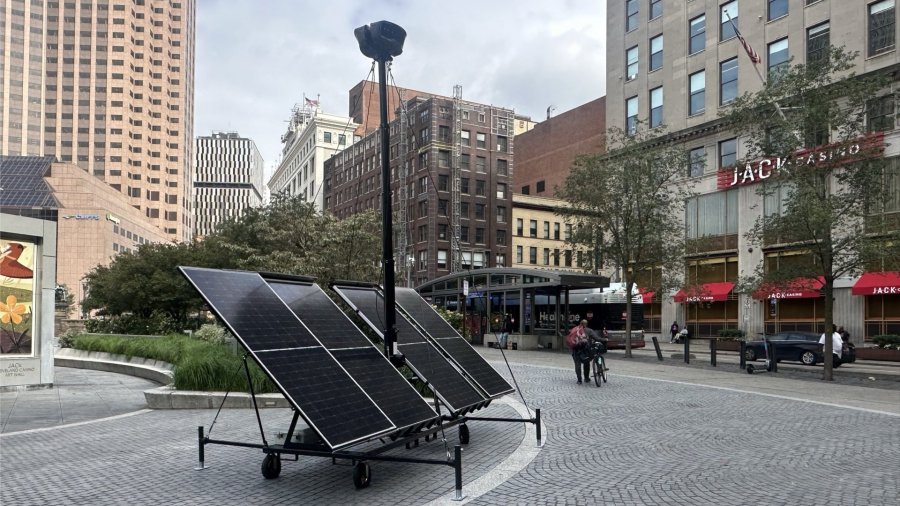How Reliable Connectivity Powers Next-Gen Security Surveillance

Security and surveillance systems have evolved far beyond traditional cameras and basic alarm panels. Today, AI-driven robots autonomously patrol perimeters, identifying potential threats with precision. Drones equipped with advanced imaging technology monitor vast areas in real time, offering unparalleled situational awareness. Meanwhile, remote video surveillance systems provide constant oversight of high-value locations such as construction sites, parking lots, and schools, enhancing both safety and response times. Additionally, lone workers operating in hazardous environments depend on reliable, instant communication to ensure rapid support during emergencies. These advancements are only possible with seamless and reliable connectivity, enabling real-time decision-making and enhanced safety across diverse environments.
One critical requirement across the spectrum of next gen security solutions is always-on cellular connectivity. When a security robot loses its network connection, it can’t do its job. When a surveillance drone can’t transmit footage, threats go undetected. When a remote camera goes dark, your assets become vulnerable.
The challenge? Traditional connectivity solutions weren’t built with the level of redundancy and performance that mission-critical security operations demand. Carrier vendor lock-in limits your options and rigid contracts prevent rapid scaling. Coverage gaps and outages create operational risk. Complex SIM logistics slow deployments to a crawl.
This post explores the cutting-edge technologies transforming connected security and how TEAL’s Network Orchestration Service (NOS) eliminates the connectivity barriers holding these innovations back.
The Rise of Autonomous Security Systems
AI-Driven Security Robots
Security robots are no longer science fiction. Companies like Vigiles Robotics deploy AI-driven robots that prevent wildfire disasters in remote, high-risk environments. RAD (Robotic Assistance Devices), Hawk Robo, Asylon Robotics, and Reconeyez offer autonomous systems that provide real-time monitoring, detect anomalies, and escalate alerts immediately.
These robots depend on LTE/4G connectivity for:
- Remote deployment in areas without fixed infrastructure
- Real-time data transmission to security operations centers
- Autonomous navigation using cloud-based AI models
- Instant incident reporting and response coordination
The problem? A single carrier failure can disable an entire security fleet. When wildfires threaten, when intruders breach perimeters, when critical infrastructure needs protection—connectivity failures aren’t just inconvenient. They’re catastrophic.
Surveillance Drones

Drones have revolutionized how organizations monitor large areas, from industrial facilities to agricultural land. They provide aerial perspectives impossible to achieve with fixed cameras, detect threats faster than human patrols, and reach locations too dangerous for personnel.
But drones face unique connectivity challenges:
- They move between different carrier coverage zones
- They operate in remote areas with spotty network access
- They need to transmit high-bandwidth video feeds without interruption
- They can’t afford downtime during time-sensitive operations
Single-carrier solutions create operational risks. When a drone enters a coverage gap, real-time monitoring stops. Critical footage might never reach operators. Response times slow down precisely when speed matters most.
Advanced Video Surveillance Solutions
Remote Monitoring Systems
Modern video surveillance extends far beyond office buildings and retail stores.
Street Smart provides smart video rental and mobile monitoring solutions for temporary deployments at construction sites, special events, and remote locations. Eagle Eye Networks (EEN) offers cloud-managed video recorders with USB modem support, keeping cameras online where wired internet doesn’t exist.
Swidget Corp’s VacantView HD LTE Cloud Smart Security Camera System eliminates WiFi dependency entirely, using cellular connectivity for flexible installation. Reconview provides cloud-managed video with cellular backup, ensuring monitoring continues even when primary networks fail.
SenseNet offers cutting-edge solutions for reliable and efficient video monitoring, even in the most challenging environments. Using advanced cellular and cloud technology, SenseNet ensures seamless connectivity for security systems, minimizing downtime and maintaining constant surveillance. Their solutions are designed for diverse applications, from urban centers to remote areas, catering to industries requiring a dependable and flexible approach to video monitoring. To learn more about their innovative services, visit SenseNet’s website.
These systems showcase a fundamental shift: security infrastructure no longer requires fixed network connections. Cellular connectivity enables deployment anywhere, anytime. But that flexibility only works when the network stays up.
License Plate Recognition and Mobile Surveillance

Genetec Inc. demonstrates how cellular connectivity powers specialized security applications. Their AutoVu SharpV ALPR system uses LTE/4G for mobile license plate recognition, enabling law enforcement to identify vehicles of interest in real time. Their Security Center SaaS integrates remote devices over cellular into cloud management platforms. Wearable and mobile video solutions stream footage from the field without requiring officers to return to base stations.
This mobility creates new security capabilities—and new connectivity requirements. When an ALPR system loses network access, it can’t cross-reference plates against databases. When mobile video can’t stream, evidence collection suffers. When remote devices disconnect from cloud management, security operations lose visibility.
Emergency Communication and Intrusion Detection
Cellular-Enabled Emergency Systems
Talkaphone’s ETP CI 4G LTE Cellular Interfaces and ETP CGW 4G GSM Cellular Gateway transform analog call stations into fully cellular-enabled emergency communication devices. This matters because landlines fail. Natural disasters damage fixed infrastructure. But cellular networks—especially with multi-carrier redundancy—provide resilience when traditional systems go down.
Acre Security offers intrusion panels with built-in LTE connectivity, including the SPCN320 GSM Module and SPCN342 2G/3G/4G Module. Their AIC 1200 intrusion panels use cellular as primary or backup connectivity, ensuring alarm signals reach monitoring centers even in network-challenged environments.
Thermal Detection and Perimeter Security
Thermal Radar’s Tower Sentry and Mobile Sentry systems use cellular-enabled remote monitoring for thermal detection and perimeter security. These systems operate in locations where running cables would be impractical or impossible—protecting critical infrastructure in remote areas, securing temporary sites, monitoring borders and coastlines.
The common thread? These solutions can’t tolerate downtime. An intrusion panel that can’t send alerts defeats its purpose. An emergency call station that can’t connect when someone needs help creates liability. A thermal detection system that goes offline during a security breach leaves facilities vulnerable.
The Connectivity Problem No One Talks About
All these innovations face the same fundamental challenge: traditional connectivity solutions weren’t designed for mission-critical operations.
Carrier lock-in forces you to accept whatever coverage and reliability your single provider offers. If their network goes down in your operating area, your security systems go down too. If they don’t have coverage where you need to deploy, you can’t expand operations. If they change pricing or contract terms, you have limited alternatives.
Coverage gaps create operational blind spots. A security robot patrolling a large facility might move in and out of coverage zones. A surveillance drone monitoring remote areas encounters carrier networks that simply don’t reach certain locations. Video surveillance systems deployed temporarily at special events struggle with congested networks.
Rigid contracts prevent rapid scaling. When you need to deploy additional security systems quickly—responding to new threats, expanding operations, testing new technologies—lengthy procurement cycles and minimum commitments slow you down. When you need to scale back seasonally or adjust to changing requirements, you’re still paying for capacity you don’t use.
Complex SIM logistics create deployment headaches. Physical SIM cards need to be procured, programmed, shipped, installed, activated, and managed. When devices need to switch carriers, you need new SIMs. When you operate globally, you need different SIMs for different regions. When SIMs fail or get lost, replacements take time.
These problems compound. Downtime becomes inevitable. Costs escalate. Flexibility disappears. Security operations become dependent on connectivity infrastructure that wasn’t built for their needs.
How TEAL NOS Solves Mission-Critical Connectivity

TEAL’s Network Orchestration Service (NOS) eliminates these barriers through a fundamentally different approach to cellular connectivity.
Multi-Carrier Redundancy
NOS provides automatic failover to backup carriers so your solutions don’t miss a beat. When your primary carrier experiences an outage, your security systems seamlessly switch to alternative networks over-the-air. This built-in redundancy eliminates single points of failure that plague traditional solutions.
For security robots, this means continuous operation even when individual carrier networks fail. For surveillance drones, this means uninterrupted video transmission as they move between coverage zones. For remote cameras, this means footage keeps recording and transmitting regardless of network conditions.
True Carrier Independence
NOS breaks vendor lock-in completely. You can switch carriers remotely without delays, without managing multiple vendor relationships, without physical SIM swaps. You’re not limited to one carrier’s coverage footprint or pricing structure. You can optimize for performance and cost simultaneously.
This flexibility transforms how you deploy security systems. Need coverage in a remote area where your current carrier has gaps? Switch to a carrier with better local coverage. Want to take advantage of better pricing from a different provider? Make the change without touching devices in the field. Operating across multiple regions with different optimal carriers? NOS handles that seamlessly.
Global Coverage, Single Platform
NOS provides access to carriers in 196 countries through one unified platform. Deploy security systems anywhere in the world without navigating different carrier relationships, contracts, or technologies in each region.
This global reach matters for organizations with distributed operations, for security providers serving clients across borders, for solutions that need to work everywhere.
Pay-As-You-Go Flexibility
NOS pricing matches how security operations actually work. Pay only for the data you use, with no minimum obligations. Need unlimited 5G for high-bandwidth video applications? NOS covers that too. Want to bring your own SIM and carrier agreements onto the platform? eSIM management is free.
This economic model eliminates the financial penalties of traditional connectivity. You’re not paying for capacity you don’t need. You’re not locked into long-term commitments that don’t match your operational reality. You can scale up or down based on actual requirements.
Centralized Management
The Aurora Dashboard provides real-time monitoring and control across your entire connectivity infrastructure. Detect issues proactively. Respond to problems before they impact operations. Manage thousands of connections from a single interface.
For security operations centers monitoring multiple sites, multiple technologies, and multiple deployment scenarios, this centralized visibility transforms operational efficiency. You know which systems are online, which are experiencing network issues, which need attention—all in one place.
Real-World Impact: What This Means for Security Operations
Consider how NOS transforms specific security scenarios:
A security robot patrol fleet operates across a large industrial complex. Traditional connectivity means some areas have poor coverage from the chosen carrier. With NOS, robots automatically connect to whichever carrier provides the best signal in each location. When a carrier network experiences localized congestion or failure, robots seamlessly switch to alternatives without losing connection to control systems.
Surveillance drones monitoring wildfire risk in remote forests need to transmit thermal imagery and video in real time. Traditional solutions struggle with coverage in these areas—often requiring expensive infrastructure investments or accepting gaps in coverage. With NOS, drones connect to whatever carrier provides the best service in each location. Multi-carrier redundancy means footage keeps transmitting even when individual networks fail.
Temporary video surveillance at construction sites needs rapid deployment without fixed infrastructure. Traditional solutions require coordinating with a single carrier, waiting for SIM cards, managing activations, and hoping coverage is adequate. With NOS, cameras deploy immediately with connectivity that automatically optimizes for available networks. When the site moves, cameras move too with connectivity that works wherever they go.
Lone worker safety systems protect employees in hazardous environments where emergency communication can save lives. Traditional connectivity creates unacceptable risk—if the carrier network fails when someone needs help, the consequences could be fatal. With NOS, multi-carrier redundancy ensures emergency alerts always get through. If one network is down, the system automatically uses alternatives.
Getting Started with NOS
Organizations serious about security can’t afford connectivity that becomes a single point of failure. TEAL NOS delivers the redundancy, reliability, and control mission-critical security operations demand.
Want to test the platform before committing? Contact a TEAL expert here: https://tealcom.io/schedule-meeting
Ready to eliminate network risk from your security operations? TEAL’s team can show you exactly how NOS transforms connectivity for your specific applications, from robotics and drones to video surveillance and emergency communication systems.
The security innovations shaping the future depend on connectivity that never fails. Make sure yours doesn’t.
Schedule a Meeting
Recent Posts
How Reliable Connectivity Powers Next-Gen Security Surveillance
Teal Communications Staff2025-11-06T20:31:43+00:00
ISC East Preview: The Future of Connected Security
Teal Communications Staff2025-11-04T19:23:15+00:00
Escape the Connectivity Graveyard: TEAL’s NOS Is Your Ghost-Free Network Solution
Teal Communications Staff2025-10-31T18:00:02+00:00





